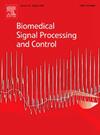Quantitative identification of blood pressure information through directly decoding intrafascicular vagal activities
IF 4.9
2区 医学
Q1 ENGINEERING, BIOMEDICAL
引用次数: 0
Abstract
The cervical vagus nerve is closely involved in blood pressure (BP) regulation, and the closed-loop vagus nerve stimulation (VNS) could mitigate concerns for neural adaptation by feeding back BP information to accomplish adaptive stimulation, making BP quantification significant. In this present study, BPs were directly decoded from vagal activities. The cervical left vagus nerves (LVNs) in eight normal Sprague-Dawley rats were intrafascicularly implanted with axon-like carbon nanotube yarn electrodes for vagal recording. Phenylephrine was intravenously injected to elevate the BPs, and LVN and systolic BP waveforms were synchronously recorded in real time. Then we quantitatively reconstructed beat-to-beat systolic BP waveforms from vagal activities using convolutional neural networks (CNNs). Three CNN models with different inputs and network structures were separately trained and tested for each rat including (1) Time–Frequency Sub-band CNN (TFS-CNN) with decomposed LVN sub-bands post wavelet transform as input and 1D convolutional layers, (2) Spectrogram-Spectral CNN (SS-CNN) with the 2D time–frequency spectrogram post Short Time Fourier Transform as input and 2D convolutional layers, and (3) Dilated Causal CNN (DC-CNN) with the same input as that in TFS-CNN and seven 1D dilated convolutional layers. It was found that the SS-CNN outperformed the other two models considering the reconstruction performance of BPs. The R2 of SS-CNN (0.78 ± 0.08, meansd) exceeded those of TFS-CNN (0.70 ± 0.13) (P < 0.05) and DC-CNN (0.53 ± 0.26) (P < 0.05). The SS-CNN model also presented the least training (4.83 ± 1.98 mmHg) and testing loss (9.91 ± 3.89 mmHg). These findings would shed some light on clinical application of the closed-loop VNS in BP regulation.
通过直接解码束内迷走神经活动定量识别血压信息
颈迷走神经与血压的调节密切相关,而迷走神经闭环刺激(VNS)可以通过反馈血压信息来实现自适应刺激,从而减轻对神经适应的担忧,这使得BP量化具有重要意义。在本研究中,bp直接从迷走神经活动中解码。在8只正常大鼠颈左迷走神经(LVNs)束内植入轴突样碳纳米管纱线电极进行迷走记录。静脉注射苯肾上腺素升高血压,实时同步记录左室神经和收缩期血压波形。然后,我们使用卷积神经网络(cnn)定量重建迷走神经活动的心跳-心跳收缩期BP波形。对每只大鼠分别训练和测试了三种不同输入和网络结构的CNN模型,分别是:(1)以分解后的LVN子带作为输入和1D卷积层的时频子带CNN (TFS-CNN),(2)以短时傅立叶变换后的二维时频谱图作为输入和2D卷积层的频谱图-频谱CNN (SS-CNN)。(3)与TFS-CNN相同输入的扩展因果CNN (DC-CNN)和7个一维扩展卷积层。考虑bp的重建性能,发现SS-CNN优于其他两种模型。SS-CNN的R2(0.78±0.08,mean±sd)高于TFS-CNN(0.70±0.13)(P <;0.05)、DC-CNN(0.53±0.26)(P <;0.05)。SS-CNN模型训练损失最小(4.83±1.98 mmHg),测试损失最小(9.91±3.89 mmHg)。这些发现将为闭环VNS在血压调节中的临床应用提供一些启示。
本文章由计算机程序翻译,如有差异,请以英文原文为准。
求助全文
约1分钟内获得全文
求助全文
来源期刊

Biomedical Signal Processing and Control
工程技术-工程:生物医学
CiteScore
9.80
自引率
13.70%
发文量
822
审稿时长
4 months
期刊介绍:
Biomedical Signal Processing and Control aims to provide a cross-disciplinary international forum for the interchange of information on research in the measurement and analysis of signals and images in clinical medicine and the biological sciences. Emphasis is placed on contributions dealing with the practical, applications-led research on the use of methods and devices in clinical diagnosis, patient monitoring and management.
Biomedical Signal Processing and Control reflects the main areas in which these methods are being used and developed at the interface of both engineering and clinical science. The scope of the journal is defined to include relevant review papers, technical notes, short communications and letters. Tutorial papers and special issues will also be published.
 求助内容:
求助内容: 应助结果提醒方式:
应助结果提醒方式:


